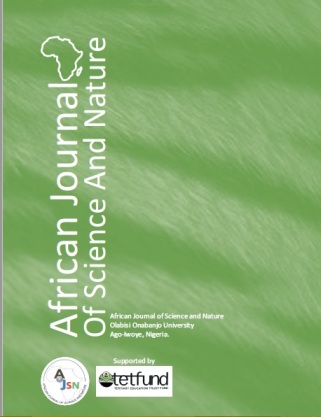FTIR Solid State Interaction of Moxifloxacine With Metals
##semicolon##
https://doi.org/10.46881/ajsn.v1i1.17##semicolon##
Quinolones##common.commaListSeparator## Moxifloxacin##common.commaListSeparator## Carbonyl groups##common.commaListSeparator## Metals ions##common.commaListSeparator## bidentate##common.commaListSeparator## polydentateAbstrakt
In this research, metal salts containing K+, Zn2+, Cu2+ and Al3+, were used to study the interaction of metal ions with moxifloxacin HCl using Solid state synthesis. The result obtained using Fourier Transform Infrared Spectra, showed a perturbation of the absorption band of the carbonyl groups at around 1700cm-1 in Moxifloxacin HCl when it was triturated in solid state synthesis with Zn2+,Cu2+ and Al3+,indicating an interaction with these metal ions. This interaction was however absent in K+ because the peak was evident at 1708.2 cm.-These interactions may have an effect on therapeutic outcome of co-administration of moxifloxacin HCl with antacids or agents containing metal ions.##submission.citations##
Alffenaar, J. W. C., van Altena R., Bökkerink H. J. (2009). “Pharmacokinetics of moxifloxacin in cerebrospinal fluid and plasma in patients with tuberculous meningitisâ€. Clinical Infectious Diseases 49 (7): 1080.
Bayer (2008a) “AVELOX (moxifloxacin hydrochloride) Tablets AVELOX I.V. (moxifloxacin hydrochloride in sodium chloride injection)†December 2008 (PDF). USA: FDA.
http://www.accessdata. fda.gov/drugsatfda_docs/label/2008/021085s039,0 21277s033lbl.pdf.
Bayer Schering Pharma (2008b). “Important Information Regarding Serious Adverse Reactions and Safety Measuresâ€.http://www.mhra.gov.uk/home/groups /plp/documents/websiteresources/con01 Assessed 29-03-2014
Catherine, M. O. & Gary, M. G. (2002). Quinolones: A Comprehensive Review. Am Fam Physician. 65(3):455-465.
Clodagh, Sheehy (2008). “Warning over two types o f a n t i b i o t i c s †. R e p u b l i c o f I r e l a n d . http://www.herald.ie/national-news/warning-over-two-types-of-antibiotic-1445498.html. Assessed 29-03-2014
Danna, L.R. & Christopher, M.R. (1990). Aqueous solubilities of some variously substituted quinolone antimicrobials, International Journal of Pharmaceutics
:3(30):237-250
Drlica, K. & Zhao X (1997). “DNA gyrase, topoisomerase IV, and the 4-quinolonesâ€. Microbiol Mol Biol Rev. 61 (3): 377–92.
Elbe, D.H.& Chang, S.W.(2005). “Moxifloxacin-warfarin interaction: a series of five case reportsâ€. Ann Pharmacother 39 (2): 361–4.
Emmerson, A. & Jones, A. (2003). “The quinolones: decades of development and useâ€. The Journal of antimicrobial chemotherapy 51(1): 13–20
Karen, E. B. (2009) “Top Ten Dangerous Drug Interactions in Long-Term Careâ€. Medication Management Project. http://www.scoup.net/m3project/topten/ #10. Assessed 19-05-2014.
Lamb, E. D. (2008).â€Top 200 Prescription Drugs of 2007". Pharmacy Times. http://www.pharmacytimes. com/issues/articles/2008-05_003. Assessed 16-04-2014
Lesher, G. Y., Froelich, E. D., Gruet, M.D., Bailey, J.H., Brundage, R.F.(1962).18 Naphthyridine derivatives. A new class of chemotherapeutic agents. J. Med Pharm Chem 5: 1063-1068.
Mohamed, A. H. I & Khalid, A. D. (2010). Pharmaceutical Chemistry (I): Note on anti-microbial agents.
University press. 1(1): 64-87.
Renata - Albrecht (2002) . “NDA 21 - 085/S - 012†(PDF). USA: Food and Drug Administration. http://www.accessdata.fda.gov/drugsatfda_docs/a ppletter/2002/21-085s012ltr.pdf. Assessed 29-03-2014
Saeed, A., Najma, S., Urooj, H., & Mesaik, M. A. (2009). Synthesis, Characterization, Antibacterial and Anti-Inflammatory Activities of Enoxacin Metal Complexes. Journal of Bioinorganic Chemistry and Applications. 914105: 5-6
Tillotson, G. S. (1996). Quinolones: structure-activity relationships and future predictions. J. Med. Microbiol. 44:320-324
Upadhya, S. K., Kumar, P & Arora, V.(2006). Complexes of quinolone drugs (norfloxacin and ciprofloxacin) with alkaline earth metal perchlorates. Journal of Structural Chemistry. 47(6):1078-1083.


